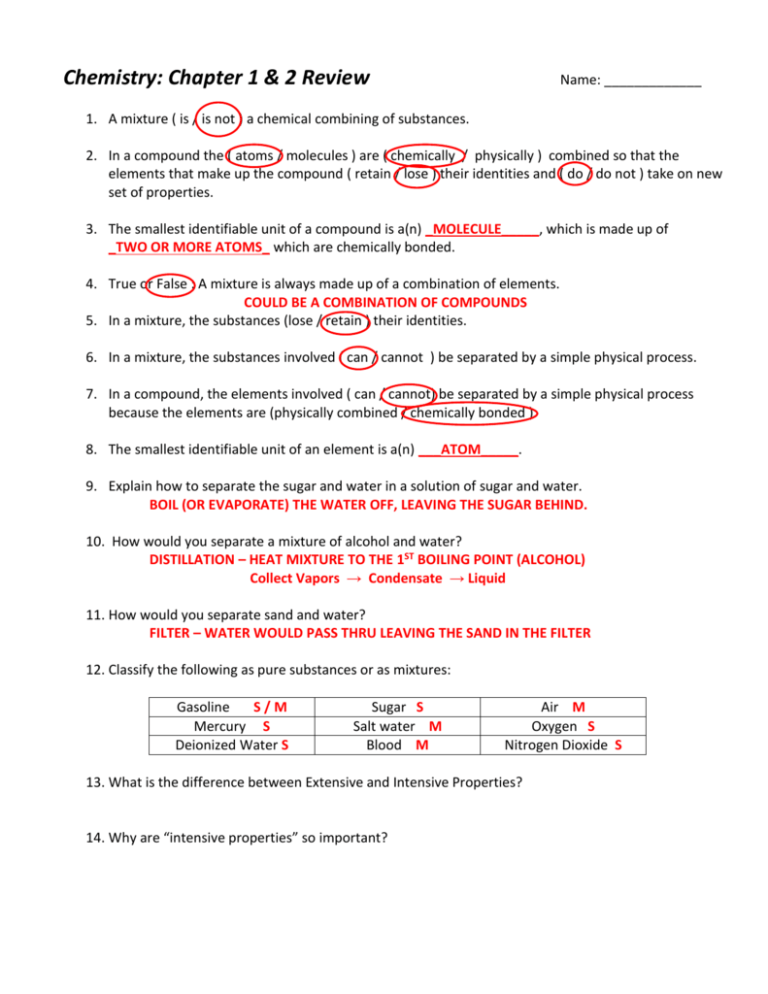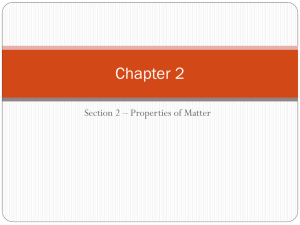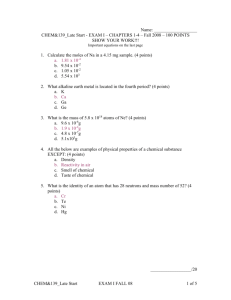Chemistry: Chapter 1 & 2 Review
advertisement

Chemistry: Chapter 1 & 2 Review Name: _____________ 1. A mixture ( is / is not ) a chemical combining of substances. 2. In a compound the ( atoms / molecules ) are ( chemically / physically ) combined so that the elements that make up the compound ( retain / lose ) their identities and ( do / do not ) take on new set of properties. 3. The smallest identifiable unit of a compound is a(n) _MOLECULE_____, which is made up of _TWO OR MORE ATOMS_ which are chemically bonded. 4. True or False : A mixture is always made up of a combination of elements. COULD BE A COMBINATION OF COMPOUNDS 5. In a mixture, the substances (lose / retain ) their identities. 6. In a mixture, the substances involved ( can / cannot ) be separated by a simple physical process. 7. In a compound, the elements involved ( can / cannot) be separated by a simple physical process because the elements are (physically combined / chemically bonded ). 8. The smallest identifiable unit of an element is a(n) ___ATOM_____. 9. Explain how to separate the sugar and water in a solution of sugar and water. BOIL (OR EVAPORATE) THE WATER OFF, LEAVING THE SUGAR BEHIND. 10. How would you separate a mixture of alcohol and water? DISTILLATION – HEAT MIXTURE TO THE 1ST BOILING POINT (ALCOHOL) Collect Vapors → Condensate → Liquid 11. How would you separate sand and water? FILTER – WATER WOULD PASS THRU LEAVING THE SAND IN THE FILTER 12. Classify the following as pure substances or as mixtures: Gasoline S/M Mercury S Deionized Water S Sugar S Salt water M Blood M Air M Oxygen S Nitrogen Dioxide S 13. What is the difference between Extensive and Intensive Properties? 14. Why are “intensive properties” so important? 15. Classify each of the properties listed below as extensive or intensive. Then classify each property as physical or chemical. Extensive or Intensive Property I I I I Property Color Combustibility Hardness Density Mass Melting Point Ductility Volume Reacts with acid Odor Weight Malleability Tendency to corrode Physical or Chemical Property P C P P P P P P E I I E I I C P P P E I I C 16. Classify each of the changes listed below as physical or chemical. Change A tire is inflated with air Milk Sours Pancakes cook on a griddle Sugar dissolves in water Physical P Chemical C C P 17. Determine the number of significant figures in the following a) 10.350 = ______5__________ b) 0.004 070 = _______4__________ 18. Perform the following calculations and write the answer using correct significant figures a) 78.100 cm + 4.9 cm = ___83.0______ b) 16.80g / 4.2 ml = ___4.0__________ 19. Write the following in scientific notation a) 0.008230 = ___8.230 X 103_________ b) 456 000 = __4.56 X 10 5_______ 20. Use dimensional analysis to make the following conversion and use correct significant figures: a) Convert 5.0 x 104 mm to km 0.05 km b) Convert 0.0074 Mm to micrometers 7.4 x 109 μm c) Convert 831 mL to L d) 27.3 m3 to liters 0.831 L Hint: 1 ml = 1 cm3 27 300 liters e) 0.13 mL to cm3 0.13 cm3 21. Use dimensional analysis, the equation for density and correct significant digits to solve the following density problems: a) Cough syrup has a density of 0.950 g/cm3. What volume of cough syrup has a mass of 50.0 g? 52.6 cm3 b) A copper penny has a mass of 3.1 g & a volume of 0.35 cm3. What is the density of the copper? 8.9 g/cm3 c) What is the mass of an object that occupies a volume of 4.5 cm3, & has a density of 19.3 g/cm3? 87 g d) A student determines the mass of a metal rod to be 39.35 g/ It is placed in 10.00 mL of water, and the water level rises to 15.00 mL. What is the density of the rod? 7.870 g/ml 22. Solve the following problems a) Convert 2 weeks to seconds 1 209 600 sec b) What are the correct units for the answer to a problem if the following series of conversion factors are used? km in mi ft m cm m ft h mi cm in ______________ c) Jules Verne wrote a book called Twenty Thousand Leagues under the Sea. Convert 20 000 leagues to fathoms. 12 in = 1 ft 3 ft = 1 yd 1 fathom = 2 yards 1 statute miles = 5280 ft 1 nautical mile = 6080 ft 1 league = 3 nautical miles 60 800 000 → 60 000 000 fathoms 23. Conversions a) 75 cm to inches 30. inches b) 2300 g to pounds 5.1 pounds c) 3.945 x 108 seconds to years 12.51 years d) 35 mi/hr to m/s 16 m/s 24. Rewrite the following numbers so that they are in proper powers of scientific notation. a) 652.3 x 105 = _6.523 x 107_______ b) 0.0259 x 108 = __2.59 x 106________ b) 759.2 x 10-6 = _7.592 x 10 -4_____ d) 0.00598 x 10-15 = _5.98 x 10-18______ 25. Calculate the percent error a) A student measures the mass and volume of a substance and calculates its density as 13.5 g/mL. The theoretical density for this substance is 15.0 g/mL. What is the percent error of the student’s measurement? 10.0 % b) Accepted Value = 0.66 cm Experimental Value = 0.55 cm 26. Round off each of the following numbers to TWO significant figures a) 0.436 _0.44_____ b) 27.2 ___27_____ c) 1.497 x 10-3 d) 9.000 __9.0_____ e) 135 ___140____ f) 0.885 Percent Error = __20. %__ __1.5 x 10-3___ ___0.88____ ***Be sure to STUDY, STUDY, STUDY your notebook!*** Read through your Catalyst, Hand notes, Worksheets, Reading Assignment, Vocabulary, etc If you have NOT nailed down a specific concept, come see me!







